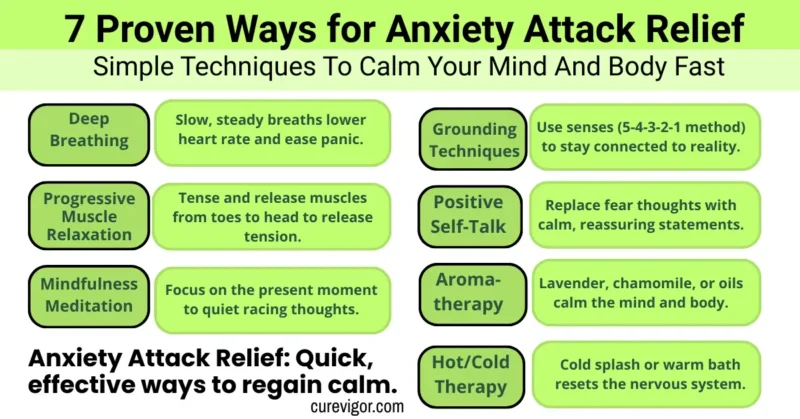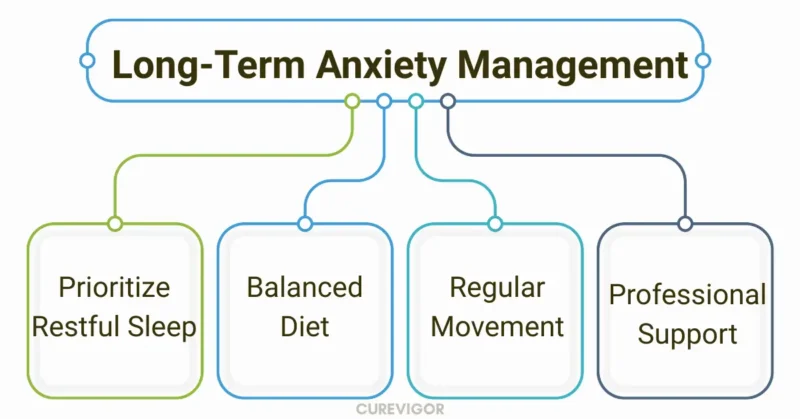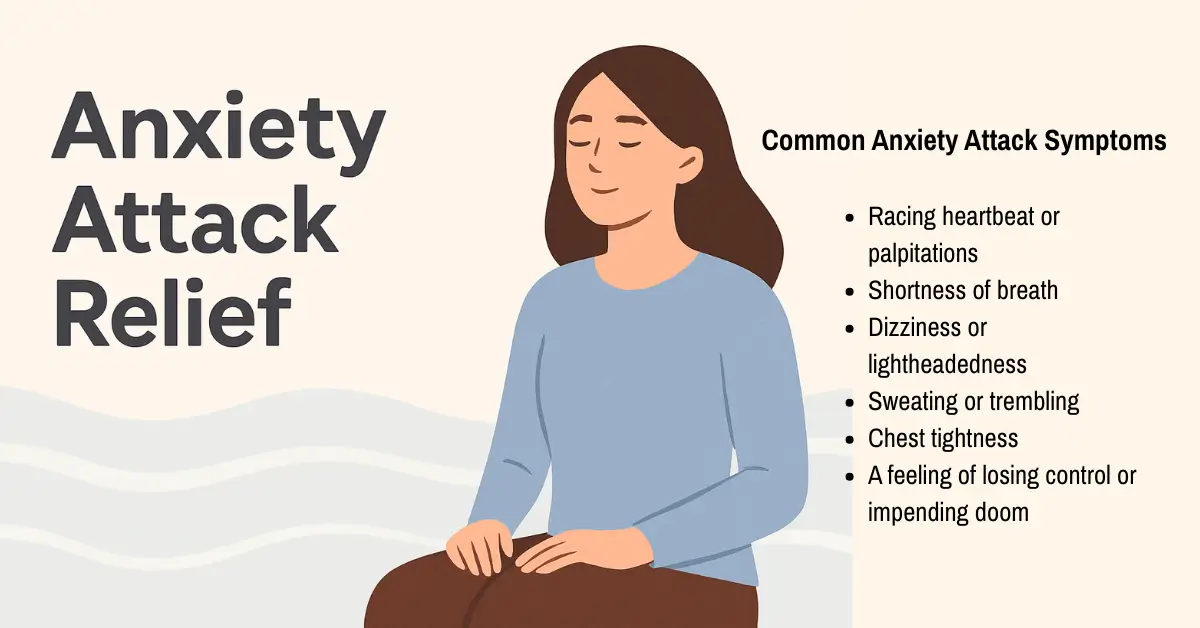Anxiety Attack Relief made simple: 7 fast techniques to ease racing thoughts, reduce stress, and bring calm when panic strikes.
Thank you for reading this post, don't forget to subscribe!If you’ve ever had an anxiety attack, you know it can feel like your body and mind have been hijacked. Your heart pounds, your breathing shortens, your thoughts race, and in those few minutes, it can feel impossible to find your footing. For some, it feels like a heart attack; for others, like losing complete control.
Anxiety attacks, though terrifying, are not permanent. You have more power to calm them than you may think. What you need are fast, practical strategies to help your body reset and remind your mind that you are safe.
How Anxiety Attack Relief Works: 7 Ways to Calm Fast
Anxiety attacks can feel like a sudden storm—your heart races, your breath shortens, and fear takes over. These moments can make even the simplest tasks feel impossible.
The good news? Anxiety Attack Relief is real, and it doesn’t always require medication. By learning a handful of proven techniques, you can train your body and mind to return to calm faster than you think.
In this guide, you’ll discover 7 proven ways to calm your mind and body fast. Each method is simple, backed by science, and something you can use anywhere — at home, at work, or even in a crowded place. Plus, we’ll cover bonus tips and long-term approaches to keep anxiety from controlling your life.
Understanding Anxiety Attacks: What Are Anxiety Attacks?
Anxiety attacks, sometimes referred to as panic attacks, are sudden, severe episodes of uneasiness or fear. They usually strike without warning, and the symptoms can mimic serious medical issues, which makes them even scarier.
Common anxiety attack symptoms include:
- Racing heartbeat or palpitations
- Shortness of breath
- Dizziness or lightheadedness
- Sweating or trembling
- Chest tightness
- A feeling of losing control or impending doom
Knowing these signs helps you recognize what’s happening and take action before symptoms escalate.
Causes of Anxiety Attacks
Anxiety attacks aren’t caused by just one thing—a blend of biological, psychological, and environmental triggers usually shows up.
- Genetics: A family history of anxiety can increase risk.
- Brain Chemistry: Neurotransmitter imbalances, such as those in serotonin or GABA, are involved.
- Stress & Trauma: Major life changes, chronic stress, or past trauma can trigger attacks.
- Medical Conditions: Thyroid issues, heart irregularities, or stimulant use (like caffeine) may contribute.
Getting to the root of your anxiety might not stop an attack in the moment, but it helps you manage them over time.
Anxiety Attack Relief: 7 Proven Ways to Calm Your Mind and Body Fast
When anxiety takes over, you want tools you can trust right now. These seven techniques have strong support from therapists and research. Try each one to see which one helps you feel calmer the fastest.

1. Deep Breathing for Anxiety Attack Relief
When anxiety takes over, it feels like your chest is closing in and your body has forgotten how to breathe. That’s because anxiety flips your nervous system into fight-or-flight mode — shallow, rapid breaths that trick your brain into thinking danger is near.
Breathing deeply is like to hitting the reset button.. It’s not just about taking in air; it’s about signaling safety to your body.
How to practice the 4-7-8 technique:
Take a slow, four-count breath through your nose. Picture the balloon-like expansion of your lungs.
- Hold that breath gently for 7 counts. This pause tells your body it has time — it doesn’t need to panic.
- Exhale through your mouth for a full 8 counts, as if you’re blowing out a candle in slow motion.
- Repeat 3–4 rounds, keeping your shoulders relaxed.
At first, it may feel awkward or forced. Stick with it. Many people notice their racing heart slows within just two minutes.
Why it works: Deep breathing lowers cortisol (your stress hormone) and steadies oxygen levels. It also shifts focus away from racing thoughts, back to the simple rhythm of your body.
2. Progressive Muscle Relaxation (PMR)
Anxiety doesn’t just live in your head — it camps out in your muscles. Tight shoulders, clenched jaw, a stiff back… sound familiar? Giving your body permission to relax is what progressive muscle relaxation is all about.
Begin with your toes: curl them tightly for 5 seconds, then fully relax them. Move to your calves: flex and hold the tension for 5 seconds, then release. Continue the sequence through each muscle group—thighs, stomach, chest, arms, shoulders, and face—tensing and relaxing each area before moving to the next.
- Move to your calves. Flex them, hold, and release.
- Continue up through thighs, stomach, chest, arms, shoulders, and finally your face.
- As you release each group, imagine tension draining out like water down a sink.
This practice does more than ease stiffness. It teaches you to notice the difference between tension and relaxation. Over time, you’ll catch anxious tension earlier — and release it before it spirals.
Why it works: Anxiety often tricks the brain into staying “on guard.” By physically relaxing your muscles, you send a powerful message back to your nervous system: We’re safe now.
3. Mindfulness Meditation
When anxiety strikes, the mind races into “what if?” territory: What if I faint? What if this never ends? Mindfulness pulls you back into this moment — where you are, right now.
How to try it in the middle of an anxiety attack:
- Sit somewhere comfortable. Close your eyes if it feels safe to do so.
- Bring attention to your breath — not trying to change it, just noticing.
- Thoughts will pop up (they always do). Instead of fighting them, picture them as clouds drifting by. Let them pass without chasing.
- Stay here for 2–5 minutes, or longer if you can.
If stillness is difficult, try walking meditation instead. As you walk slowly, direct your attention to the feeling of your feet making contact with the ground with every step. Stay focused on the sensation, using your body’s movement as an anchor for your mind.
Why it works: In addition to lowering heart rate and triggering the relaxation response, mindfulness teaches your brain to ride the wave of worry rather than drown in it.
4. Grounding Techniques to Stop Anxiety Fast
When anxiety hits, you often feel trapped in your head — spinning thoughts, worst-case scenarios, spirals you can’t stop. Grounding pulls you out of the storm and plants you back in reality.
Try the 5-4-3-2-1 technique: Name 5 things you can see around you—such as a pen, a window, your shoes, a light, or a book.
- Find 4 things you can feel. Pay attention to sensations like the chair beneath you, your feet on the floor, the texture of your shirt, or the temperature of a table.
- Listen for 3 distinct sounds. Notice background noises, such as distant traffic, a humming fan, or birds outside.
- Identify 2 things you can smell, such as coffee, soap, or fresh air.
- Focus on 1 thing you can taste, even if it’s only the lingering taste in your mouth.
It sounds simple, but the shift can be profound. Suddenly, instead of being lost in “what if,” you’re anchored in “what is.”
Why it works: Grounding activates your senses, pulling your attention away from spiraling thoughts and into the tangible, safe present moment.
5. Positive Self-Talk & Thought Reframing
Anxiety’s cruelest trick is the voice in your head whispering: “You can’t handle this.” The truth? You can. But you need to rewrite that inner script.
How to reframe in the moment:
- Swap “I’m losing control” with “I’ve been through this before, and it always passes.”
- Replace “I can’t breathe” with “My breath feels tight now, but I’m safe and it will slow.”
- Use affirmations like: “This is temporary. I am safe. I am stronger than this feeling.”
If you struggle to remember in the moment, write calming statements on sticky notes or in your phone so they’re ready when you need them.
Why it works: Self-talk directly influences your brain’s fear center (the amygdala). Reassuring words literally help dial down the panic response.
6. Aromatherapy for Instant Calm
Scent is powerful — it bypasses logic and connects straight to the emotional center of the brain. That’s why certain smells instantly remind us of childhood, home, or comfort.
Best essential oils for anxiety relief:
- Lavender: Known to lower blood pressure and heart rate.
- Chamomile: Eases restlessness and prepares the body for rest.
- Bergamot: A citrus oil that lifts mood while calming tension.
Place a few drops into a diffuser near your bed or desk, allowing the aroma to spread throughout your space.
- To inhale straight from your skin, mix essential oil with a carrier oil and gently massage it into your wrists or temples.
- Put a drop of essential oil on a tissue, hold it near your nose, and inhale slowly. You can keep the tissue with you to breathe in the scent when needed throughout the day.
Why it works: Smell signals travel directly to the brain’s limbic system, which governs emotions and memory. The right scent can override stress signals and help your body shift into a more relaxed state.
7. Hot or Cold Therapy
Temperature is one of the fastest ways to influence your nervous system. When anxiety spikes, sudden heat or cold can jolt your body back to balance.
Cold options:
- Splash cold water on your face (especially around eyes/cheeks).
- Hold an ice cube in your hand and focus on the sharp sensation it produces.
- Place a cold compress on the back of your neck.
Hot options:
- Take a warm shower and let the water hit tense muscles.
- Use a heating pad on your shoulders or stomach to relieve discomfort.
- Sip a warm herbal tea, such as chamomile or peppermint.
Why it works: Cold stimulates the vagus nerve, which helps regulate heart rate and calm your nervous system. Heat, on the other hand, soothes tense muscles and signals a sense of comfort. Both methods act as a physical reset when your body feels hijacked by anxiety.
Bonus Relief Options Worth Trying
Sometimes the best Anxiety Attack Relief comes from simple shifts that move your body and mind out of panic mode. Alongside the seven core techniques, these bonus options are quick, effective, and easy to use anytime anxiety sneaks up on you.
Physical Activity
When anxiety hits, it often feels like you’re filled with nervous energy you can’t release. Moving your body helps burn off that excess adrenaline. Even something as small as a five-minute walk around the block or gentle stretches in your living room can trigger the release of endorphins — your body’s natural mood-lifters.
Yoga is beneficial because it combines breath control, grounding, and movement in one practice. If leaving home feels impossible, try simple poses like Child’s Pose or Legs Up the Wall to gently shift your nervous system into a calm state.
Visualization
The mind doesn’t always distinguish between imagination and reality. That’s why guided visualization is such a powerful tool for relieving anxiety attacks.
Close your eyes and picture a place where you feel safe — maybe a quiet beach, a forest trail, or even your childhood bedroom. Engage all your senses: imagine the smell of pine trees, the sound of waves, or the softness of blankets.
By painting this scene in detail, you give your brain an alternative focus and a sense of safety. Visualization apps and guided imagery videos can help if creating a scene feels difficult during an attack.
Long-Term Anxiety Management
Quick techniques are essential during an attack, but lasting Anxiety Attack Relief requires building a foundation of habits that support your nervous system every day.

Think of these practices as preventative care: they make your body more resilient and your mind less likely to spiral.
Prioritize Restful Sleep
Anxiety and sleep have a complicated relationship. Poor sleep increases anxiety, and anxiety makes sleep harder. Try to get 7 to 9 hours of good sleep per night to stop the cycle.
Establish a relaxing evening routine by turning out the lights an hour before bed, avoiding electronics, and letting your body know it is time to relax with a warm herbal tea.
Balanced Diet
Food directly impacts mood and energy. A diet heavy in caffeine and sugar can exacerbate anxiety symptoms and cause jitters. For better long-term stability, focus on:
- Steady meals with protein, whole grains, and vegetables.
- Limiting stimulants like coffee and energy drinks.
- Hydration since dehydration often intensifies stress responses.
Regular Movement
Exercise doesn’t just keep your body strong — it balances brain chemistry. Studies show that even 20 minutes of moderate movement (walking, cycling, dancing) can lower anxiety levels and boost serotonin.
Pick activities you enjoy, so exercise feels like self-care, not a chore. The more consistent you are, the more resilient you’ll feel against future anxiety attacks.
Professional Support
Expert assistance can be crucial if anxiety attacks are regular or interfere with day-to-day functioning. Cognitive behavioral therapy (CBT), which teaches you to identify and alter your anxious thought patterns, is among the finest treatments.
A healthcare provider may also recommend medication for individuals who require additional support. Reaching out isn’t weakness — it’s an act of strength and self-care.
Takeaway: Quick strategies stop anxiety in the moment, but long-term Anxiety Attack Relief is about lifestyle. By combining both, you give yourself the best chance not only to calm attacks when they happen but also to reduce their intensity and frequency over time.
FAQs
Q. What is the fastest Anxiety Attack Relief technique?
For most people, deep breathing is the quickest way to relieve anxiety attacks. In just a few minutes, slow, deliberate breathing can help you control your heart rate and reduce your adrenaline levels.
Techniques like 4-7-8 breathing or box breathing are especially effective. Pairing breathing with grounding methods, such as the 5-4-3-2-1 sensory exercise, can stop spiraling thoughts.
Everyone’s body responds differently, so it helps to practice several techniques. Over time, you’ll discover which strategy works best for calming your mind and body quickly.
Q.. Can Anxiety Attack Relief work without medication?
Yes, many people find Anxiety Attack Relief through natural methods without medication. Effective stress-reduction strategies include visualization, mindfulness meditation, and progressive muscle relaxation.
Aromatherapy and temperature shifts, such as cold water therapy, can also bring about a rapid sense of calm. Lifestyle habits, including regular sleep, exercise, and a balanced diet, reduce the frequency of attacks.
While medication helps some, it’s not the only option. If attacks are frequent, combining therapy with natural techniques often provides lasting relief. Always consult a professional if symptoms interfere with daily life.
Q. How can I calm my body during an anxiety attack?
The first step in calming your body during an anxiety attack is to relax your nervous system with deep breathing. Progressive muscle relaxation, which entails tensing and relaxing each muscle in the body, is another useful method.
The vagus nerve is rapidly stimulated by cold therapy, such as splashing water in your face, which reduces stress signals. Excess adrenaline can be burned off through light exercise, such as stretching or strolling.
Scents used in aromatherapy, like chamomile or lavender, can help reduce stress. When your body feels overpowered, these methods work together to create a potent toolkit for anxiety attack relief.
Q. What are natural remedies for Anxiety Attack Relief?
Natural remedies for Anxiety Attack Relief include mindfulness meditation, grounding exercises, aromatherapy, and herbal teas. Lavender and chamomile essential oils are widely studied for their calming effects.
Visualization techniques, such as imagining a safe place, help redirect focus away from fear. Yoga and light exercise reduce stress hormones and balance mood. A warm bath or heat therapy relaxes tense muscles, while cold exposure quickly resets your system.
These holistic approaches not only ease attacks in the moment but also strengthen long-term anxiety management.
Conclusion
Anxiety attacks are overwhelming, but they don’t define you. With the right tools, you can take back control, calm your body, and quiet your mind.
The techniques we’ve explored — from deep breathing and grounding exercises to aromatherapy and hot/cold therapy — are not complicated. They’re small, practical steps toward real Anxiety Attack Relief.
The next time panic strikes, remind yourself:
- This moment will pass.
- You have strategies that work.
- Each attack you manage builds confidence for the next one.
Long-term habits, such as maintaining better sleep, practicing mindful movement, and seeking professional support, will make these techniques even more effective. Think of it as building an anxiety safety net — so when an attack happens, you know you won’t fall too far.
If you found these techniques helpful, consider bookmarking this guide and sharing it with someone who may need it. Relief doesn’t always come instantly, but with practice, it comes faster each time.
You’re not powerless. You’re learning the skills to take back your calm — one breath, one moment, and one technique at a time.
Read more articles on Health and Wellness Tips.
You might like to read:

